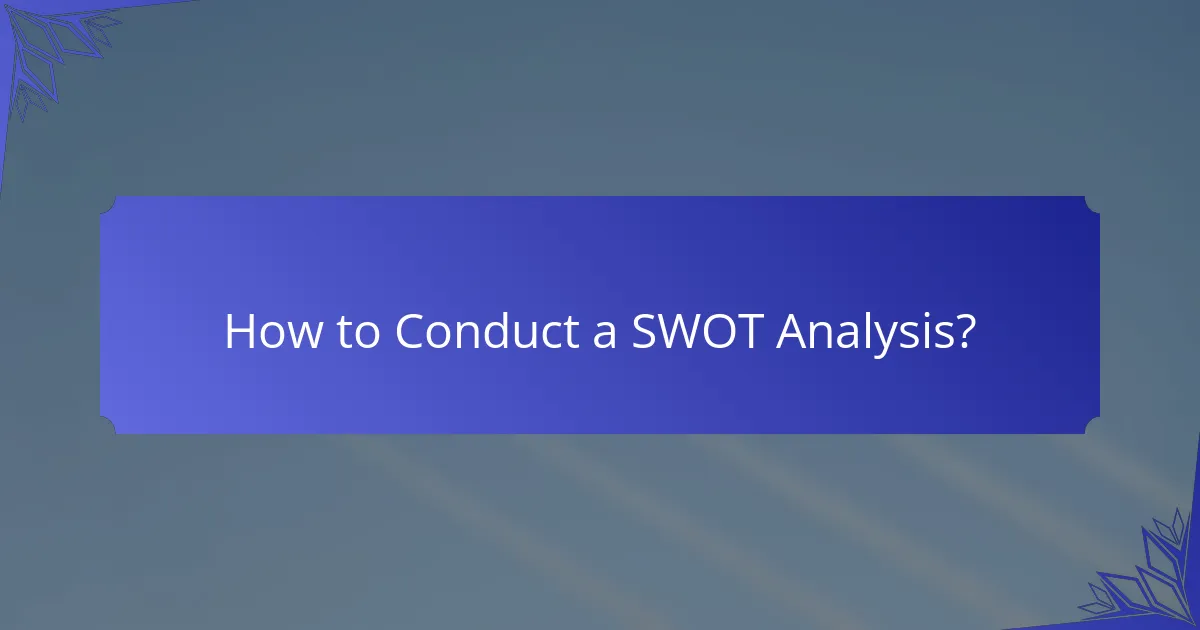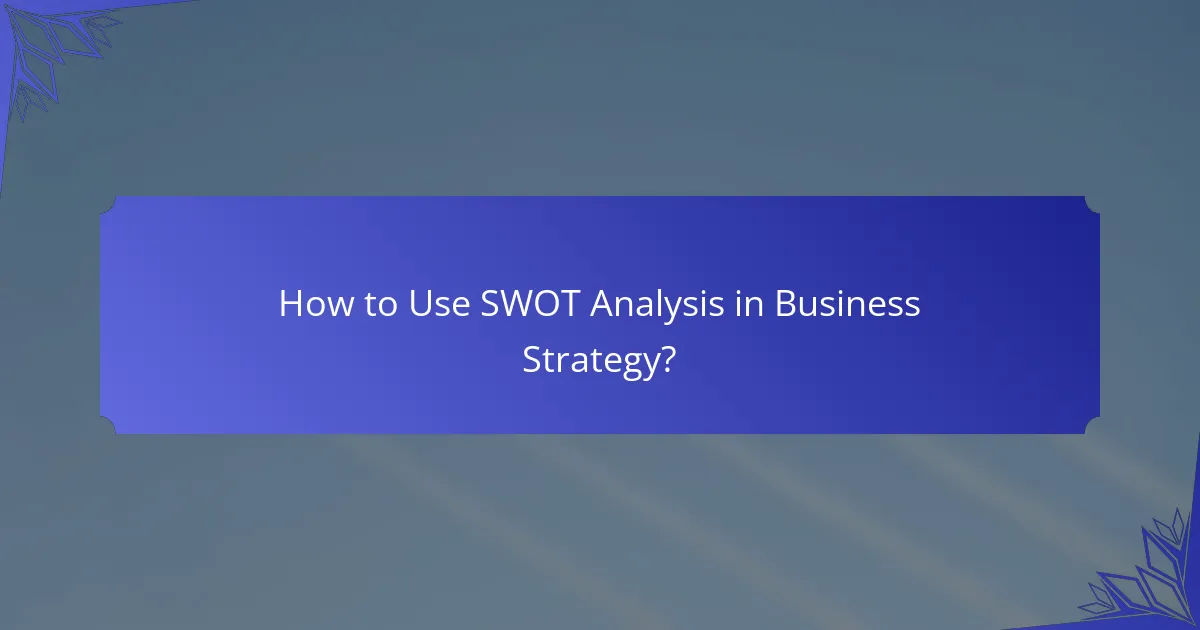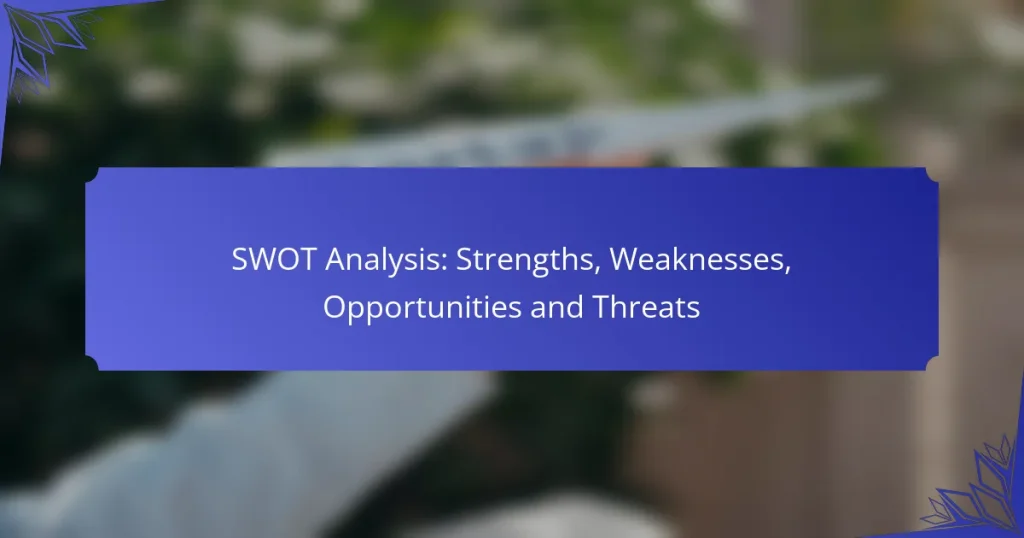A SWOT analysis is a vital strategic planning tool that enables organizations to identify their strengths, weaknesses, opportunities, and threats. By systematically evaluating these four components, businesses can make informed decisions and craft strategies that align with their objectives and market dynamics.

How to Conduct a SWOT Analysis?
A SWOT analysis is a strategic planning tool used to identify an organization’s strengths, weaknesses, opportunities, and threats. Conducting a SWOT analysis involves gathering relevant information and assessing internal and external factors that can impact the success of a project or business.
Identify strengths
To identify strengths, focus on the internal attributes that give your organization a competitive advantage. Consider resources such as skilled personnel, proprietary technology, strong brand reputation, or financial stability.
Engage team members in discussions to uncover unique capabilities. For instance, a company with a highly experienced workforce may list this as a key strength, while another might highlight its innovative product line.
Determine weaknesses
Weaknesses are internal factors that hinder performance or put the organization at a disadvantage. Assess areas such as limited resources, skills gaps, or poor location.
Conduct a candid evaluation by soliciting feedback from employees and stakeholders. For example, a business with outdated technology may recognize this as a weakness that needs addressing to remain competitive.
Explore opportunities
Opportunities are external factors that the organization can leverage for growth. Identify trends, market gaps, or changes in regulations that could benefit your business.
For example, a rise in demand for eco-friendly products can present an opportunity for companies to innovate and expand their offerings. Regularly monitor industry news and consumer behavior to stay informed about potential opportunities.
Assess threats
Threats are external challenges that could negatively impact the organization. These may include increased competition, economic downturns, or changes in consumer preferences.
Evaluate the competitive landscape and market conditions to identify potential threats. For instance, a new competitor entering the market with lower prices could pose a significant threat to existing businesses.
Compile findings
After gathering insights on strengths, weaknesses, opportunities, and threats, compile your findings into a clear and concise format. A SWOT matrix can be useful for visual representation, allowing for easy comparison.
Review the compiled analysis with stakeholders to ensure alignment and gather additional insights. This collaborative approach can help refine strategies and prioritize actions based on the SWOT analysis outcomes.

What Are the Benefits of SWOT Analysis?
SWOT analysis is a strategic planning tool that helps organizations identify their strengths, weaknesses, opportunities, and threats. By systematically evaluating these four aspects, businesses can make informed decisions and develop effective strategies.
Improves strategic planning
SWOT analysis enhances strategic planning by providing a clear framework for evaluating internal and external factors. Organizations can align their resources and capabilities with market opportunities, ensuring that strategies are realistic and achievable.
For example, a small business might identify its strong customer relationships as a strength and leverage that to expand into new markets. This alignment helps prioritize initiatives that can maximize growth potential.
Enhances decision-making
By highlighting critical factors that influence performance, SWOT analysis improves decision-making processes. It encourages leaders to consider both positive and negative elements, leading to more balanced and comprehensive choices.
A company facing increased competition might use SWOT to assess its unique selling propositions and decide whether to invest in marketing or product development. This informed approach reduces the risk of making hasty decisions based on incomplete information.
Identifies competitive advantages
SWOT analysis helps organizations pinpoint their competitive advantages by revealing strengths that can be leveraged against competitors. Understanding these advantages allows businesses to differentiate themselves in the marketplace.
For instance, a tech firm may identify its innovative product features as a strength, which can be emphasized in marketing campaigns. Recognizing these advantages enables companies to focus their efforts on what sets them apart, enhancing their market position.

How to Use SWOT Analysis in Business Strategy?
SWOT analysis is a strategic planning tool that helps businesses identify their strengths, weaknesses, opportunities, and threats. By systematically evaluating these four areas, companies can develop effective strategies that align with their goals and market conditions.
Integrate with business goals
To effectively use SWOT analysis, ensure that it aligns with your overall business goals. Start by identifying key objectives and then assess how each element of the SWOT analysis supports or hinders these goals.
For example, if a business aims to expand into new markets, its strengths might include a strong brand reputation, while weaknesses could involve limited distribution channels. This alignment helps prioritize actions that directly contribute to achieving strategic objectives.
Align with market trends
SWOT analysis should reflect current market trends to remain relevant. Regularly update your analysis to incorporate changes in consumer behavior, technological advancements, and competitive dynamics.
For instance, if there is a growing demand for sustainable products, a company might identify this as an opportunity while also recognizing threats from competitors who are already established in that space. This proactive approach allows businesses to adapt and seize new opportunities effectively.
Facilitate team discussions
Using SWOT analysis can foster collaborative discussions among team members. Encourage diverse perspectives by involving individuals from various departments, as this can lead to a more comprehensive understanding of the business landscape.
Consider organizing workshops where teams can brainstorm and categorize their insights into the SWOT framework. This not only enhances team engagement but also uncovers insights that may not surface in isolated discussions, ultimately leading to more robust strategic planning.

What Are Common Mistakes in SWOT Analysis?
Common mistakes in SWOT analysis include failing to consider external factors and not prioritizing the identified strengths, weaknesses, opportunities, and threats. These oversights can lead to an incomplete understanding of the situation, impacting strategic decision-making.
Overlooking external factors
One significant mistake in SWOT analysis is neglecting external factors that can influence an organization. This includes market trends, economic conditions, and competitive landscape changes. For instance, a company may focus solely on internal strengths without recognizing a shift in consumer preferences that could affect its market position.
To avoid this pitfall, regularly conduct market research and competitor analysis. This ensures that external influences are incorporated into the SWOT framework, providing a more comprehensive view of the business environment.
Failing to prioritize elements
Another common error is not prioritizing the elements identified in the SWOT analysis. Listing numerous strengths, weaknesses, opportunities, and threats without ranking them can dilute focus and hinder effective strategy development. For example, a company might identify several opportunities but fail to recognize which ones align best with its core competencies.
To effectively prioritize, use a scoring system or matrix to evaluate the impact and feasibility of each element. This helps in making informed decisions about where to allocate resources and efforts for maximum effect.

How to Leverage SWOT Analysis for Marketing?
SWOT analysis is a strategic tool that helps businesses identify their strengths, weaknesses, opportunities, and threats in marketing. By understanding these elements, companies can create more effective marketing strategies that align with their goals and target audience.
Identify target audience strengths
Recognizing the strengths of your target audience is crucial for tailoring marketing efforts. These strengths may include demographic characteristics, purchasing power, brand loyalty, or specific interests that align with your offerings.
For instance, if your target audience consists of tech-savvy millennials, emphasize innovative features and digital engagement in your marketing campaigns. Understanding these strengths allows for more personalized messaging that resonates with potential customers.
To effectively identify these strengths, conduct market research through surveys, focus groups, or social media analytics. This data can reveal valuable insights into what drives your audience’s purchasing decisions.


